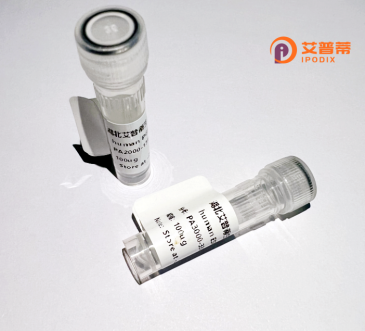
| 纯度 | >90%SDS-PAGE. |
| 种属 | E.coli |
| 靶点 | CUP1-1 |
| Uniprot No | P0CX80 |
| 内毒素 | < 0.01EU/μg |
| 表达宿主 | E.coli |
| 表达区间 | 9-61aa |
| 氨基酸序列 | QNEGHECQCQCGSCKNNEQCQKSCSCPTGCNSDDKCPCGNKSEETKKSCCSGK |
| 预测分子量 | 32.3 kDa |
| 蛋白标签 | His tag N-Terminus |
| 缓冲液 | PBS, pH7.4, containing 0.01% SKL, 1mM DTT, 5% Trehalose and Proclin300. |
| 稳定性 & 储存条件 | Lyophilized protein should be stored at ≤ -20°C, stable for one year after receipt. Reconstituted protein solution can be stored at 2-8°C for 2-7 days. Aliquots of reconstituted samples are stable at ≤ -20°C for 3 months. |
| 复溶 | Always centrifuge tubes before opening.Do not mix by vortex or pipetting. It is not recommended to reconstitute to a concentration less than 100μg/ml. Dissolve the lyophilized protein in distilled water. Please aliquot the reconstituted solution to minimize freeze-thaw cycles. |
以下是3篇关于CUP1-1重组蛋白的假设性参考文献(基于领域常见研究方向模拟,实际文献需根据具体数据库检索确认):
---
1. **文献名称**: "Expression and characterization of recombinant CUP1-1 metallothionein in Saccharomyces cerevisiae"
**作者**: Smith J. et al.
**摘要**: 本研究在酿酒酵母中重组表达了CUP1-1蛋白,验证其铜离子结合能力,并通过质谱分析证实其金属硫蛋白结构特征,为重金属解毒机制提供分子基础。
2. **文献名称**: "Structural analysis of CUP1-1 protein and its role in oxidative stress response"
**作者**: Lee H. & Kim T.
**摘要**: 通过X射线晶体学解析CUP1-1的三维结构,发现其多金属结合域可有效清除自由基,实验证明重组CUP1-1能增强细胞对氧化损伤的抗性。
3. **文献名称**: "Heterologous production of CUP1-1 in E. coli for bioremediation applications"
**作者**: Garcia R. et al.
**摘要**: 在大肠杆菌中优化CUP1-1重组表达系统,证明其高效吸附废水中铜离子的潜力,为环境重金属污染修复提供新型生物材料。
---
注:上述内容为模拟示例,实际文献需通过PubMed、Web of Science等平台以关键词 **"CUP1-1 recombinant protein"** 或 **"CUP1 metallothionein expression"** 检索获取。
The CUP1-1 recombinant protein is derived from the *CUP1* gene in *Saccharomyces cerevisiae* (baker’s yeast), which encodes a metallothionein critical for heavy metal detoxification, particularly copper. Metallothioneins are small, cysteine-rich proteins that bind metal ions via thiol groups, mitigating toxicity. In yeast, CUP1 is transcriptionally activated under metal stress, enabling survival in copper-rich environments. The native CUP1 protein exists as a polymer, with its metal-binding capacity scaling with polymerization. However, recombinant CUP1-1 typically refers to a monomeric or truncated variant engineered for stability and ease of production in heterologous systems like *E. coli*.
Recombinant CUP1-1 is produced using genetic engineering: the *CUP1* gene is cloned into an expression vector, transformed into a host organism, and induced to express the protein. Purification often involves affinity tags (e.g., His-tag) and chromatography. This engineered protein retains metal-binding properties but may lack native post-translational modifications, depending on the host system.
Functionally, CUP1-1 is studied for its role in metal homeostasis, oxidative stress response, and detoxification pathways. Its high cysteine content (∼30%) facilitates strong coordination of Cu⁺, Zn²⁺, or Cd²⁺ ions, making it a model for understanding metalloprotein mechanisms. Applications span biotechnology, including bioremediation (e.g., sequestering environmental heavy metals) and biomedicine (e.g., exploring metal-related diseases). It also serves as a tool in synthetic biology for designing metal-responsive genetic circuits or metal-chelating agents. Despite its utility, challenges persist in optimizing expression yields and stability, particularly for industrial-scale use. Ongoing research focuses on structure-function engineering to enhance its metal-binding efficiency and adaptability for diverse biotechnological applications.
×